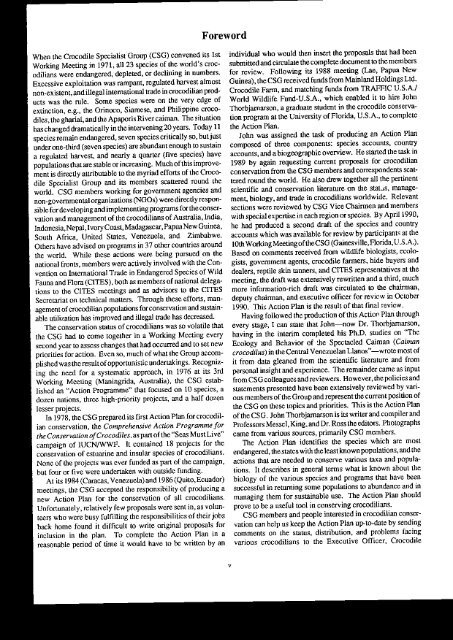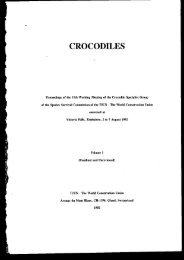size: 7451KB - Crocodile Specialist Group
size: 7451KB - Crocodile Specialist Group
size: 7451KB - Crocodile Specialist Group
You also want an ePaper? Increase the reach of your titles
YUMPU automatically turns print PDFs into web optimized ePapers that Google loves.
Foreword<br />
when the Crocodlle <strong>Specialist</strong> <strong>Group</strong> (CSG) convened its lst individual who would lhen insert the proposals that had becn<br />
Working Moeting in 1971, all 23 species of tho world's clocoalilians<br />
were endangcred, deplered, or declining in numbers' for review. Following its 1988 rne€ting (Ine' Papua New<br />
s[bmitted and circulate the complele document !o the membe<br />
Excessive exploitation was rampant, regulated harvest almost Guinea), the CSG rcceivcd funds from Mainland Holdings Ltd.<br />
non'existent, and illegal intemational tsade in crocodilian products<br />
was the rule. Some species were on tho very edge of world wildlife Fund-U.S.A., which enabled it to hire John<br />
Crocodrlo Farn, and matching funds from TRAFFIC U S A /<br />
extinchon, e.g., the Onnoco, Siamese, and Philippine crocodilcs,thegharial,andfieApaporisRivercaiman<br />
Thesiluation Uor program at the Univcrsity ofFloriala' U.S.A.' lo comple@<br />
Thorbjamarson, a graduate student in lhe crocodile conservahas<br />
changed dmmatically in thc intervening m years. Today I I tho Action PIan.<br />
specics remain endangcred, seven species critically so' buliust John was assigned the task of producing an Action Plan<br />
u;derone-third (sevcn specjcc' ate abundant enough !o su5l,in composcd of thrce components: species accounts, country<br />
a regulaled harvest, and nearly a quarter (five species) have accounls,andabiogeogmphicoverview Hestanedthetaskin<br />
DoDulationsthatares6bleorinqoasing Muchof lhisimprovem;nt<br />
is directly altribuBblc 10 the myriad efforts of thc Croco' colervation ftom the CSG memb€rs and correspondentscat_<br />
1989 by aSain requesting current proposals for qocodilian<br />
dile <strong>Specialist</strong> <strong>Group</strong> and its members scattered round lho tered round lhe world. He also drow together all ihe penincnl<br />
world. CSC membcrs worling for govemmen( agencies and scientific and conservation liloraturc on the statJs, management,<br />
biology, and Fade in crocodilians worldwide. Relevant<br />
non-govemmenlalorganizations OIGOS) wcredirecdvrespon'<br />
sible for dcveloping and implcmenting Foglams for the consorvadon<br />
and managgmcnl of lhe crocodilians of Ausralia' lnds' with sp€cial expenise in each rcgion or species. By April 1990'<br />
scclions were rcviewed by CSC Vice Chalrmen and members<br />
Indoncsia, Nepal,Ivory Coast, Madagascar, Papua New Guinea, he had produccd a second alrafi of the spc4ies and country<br />
South Africa, United Stalcs, Venczuela, and Zimbabwe. accounB which was avarlable for review by partrcipanls at fie<br />
Others have advised on Fograms in 37 other counlries around 1ofi working Meedng of6eCSG (Gainesvi[e,Florida,U.S A.).<br />
fic worlil. While thcse actions were bcing pursucd on the Ba-seal on commenls receivcd from wildlife biologists, ecologists,<br />
govemment agents, crocodilo farmers, hide buyers and<br />
national ftonls. members werc achvely involved with $e Con_<br />
vention on Intcmational Trade in Endangered Species of Wild alealers, reptile skin tanners, and CITES EprcsenLltivcs at the<br />
Fauna and Flora (CITES), bolh ax members of national delegadons<br />
lo the CITES mcelings and as advisors !o thc CI]ES more information-rich draft was circulated lo the chatman'<br />
meeling, the draft was exlensively rewritten and a third' much<br />
Secrct riat on technical matters Through thcse effons, managemenl<br />
of crocodjlian populatrons for consc alionandsustain-<br />
l9m. Thir Aclion Plan is dle resull of thal final tevicw.<br />
deputy chairman, and executivo officer for rcvicw in October<br />
able ulilizalion has improved and illegal trade has decre3sed Having followed the produclion oflhis Acdon Plan hrough<br />
The conservalion slatus of crocodilians was so voladle that every stage, I can state that John now Dr' Thorbjamalson,<br />
the CSG had to come together in a Working Mceting every having in the interim completed his Ph.D. studics on "Thc<br />
se.ond ycar to asscss changes that had occurrecl and to set ncw Ecology and Behavior of fe Spechcled Caiman (Co,,'Id,<br />
priorilies foraction. Even so, much of what fte <strong>Group</strong> accomplished<br />
was thc resuh of opportunisuc underulings- Recogniz-<br />
il from dala gleaned from the scignlific litemlure and fmm<br />
cro.rd,r$) in the Central Venczuelan Llanos"-wrote mosl of<br />
ing thc need for a systematic approach, in 1976 at iK 3rd personal insight snd experience The rcmainder came as rnput<br />
Working Mccdng (Maningrida, Australia), lne CSG carablishcd<br />
an "Action Progamme" that focused on 10 specics, a stalcments presenied have been exlensively reviewed by vari-<br />
from CSG colleagucs and reviewers. Howcver' lhe policies and<br />
dozen nalions, thrco high'priority p.ojccls, and a half dozen ous mcmbers of the <strong>Group</strong> and representhe cunent position of<br />
lesserprojects.<br />
$o CSG on 6esc topics and priorities. This is $e Actjon Plan<br />
In 1978. the CSG prepared its first Action Plan for crocodilian<br />
conservalion, the Conprehe^si're Action Prcerumnz Jor hotessorsMesscI,King,and Dt.Rosstheedilor( Pholographs<br />
of the CS G. John Thorbjamarson is its wri@r and compiler and<br />
I he C o nset vation of C ro c odiler, as panof thc "Seas MustLive" came from various sources, primarily CSG members.<br />
campaign of IUCN/^fiwF. It containcd 18 projecls for ihe The Action Plan idendfies thc species which are most<br />
conse alion of cstuarine and insular sp€cies of crocodilians. endangered, lhe statcs with the least krcwn populadons, and thc<br />
Nonc of the projecls was cver funded as part of $e campaign' aclions thal ffe necded to conscrve various |axa and popula_<br />
bu( four or five were undcrt2ken with outsidc funding. dons. n describcs in general terms what is known aboul the<br />
At iis 1984 (Camcas, Veflezuela) and 1986(Quilo'Ecuador) biology of lbc various species and programs that have been<br />
meetings, lhe CSG accepted lhe responsibility of producing a successful in reluming some populations !o abundance and in<br />
new Action Plan for the conservation of all crocodilians- managing lhem for sustainable use. fie Aclton Plan should<br />
Unfonunalely, relatively few proposals were scnt in, as volunleers<br />
who wcre busy fulfilling lhc responsibilities of &eir jobs CSG members and peoplc intercstcd in crccodilian conser-<br />
orove to be a useful tool in conserving crocodilians.<br />
back home found it difficult 0o write original proposals for vation canhelp us keep the Actlon Plan uPto-date by sending<br />
inclusion in the plan. To complele thc Action Plan in a comments on tie status, distribudon, and problems facing<br />
reasonable period of time i! would have to bc writaen by an various crocodilians 10 the Executive Officer, <strong>Crocodile</strong>

















